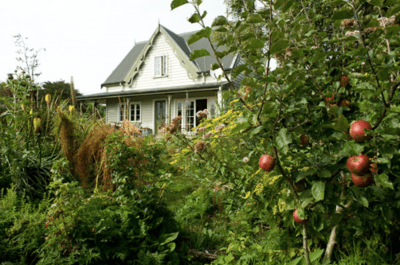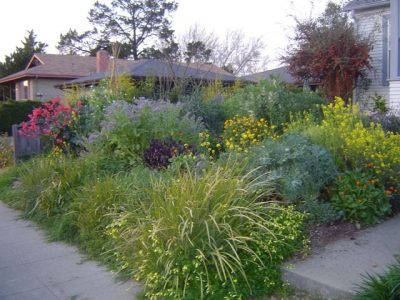What Is A Food Forest?
A food forest is an edible landscape that mimics a natural forest in form and function. Natural systems don’t require human inputs to flourish. Instead, the various species form a web of interconnection where they feed off and support each other in a closed, sustainable system. In these systems each plant serves more than one function (i.e. accumulating nutrients, producing mulch, attracting beneficial insects etc.).
When we design and plant a food forest our goal is to create a system that produces food, habitat and medicine while requiring very little human input.
Layers Of A Food Forest
Just like in an actual forest, a food forest has many layers with different species of plants inhabiting each layer. For example, tall trees create a canopy layer, providing shade, harvesting water (from fog), producing mulch and creating a sheltered area in which other plants can grow.
Below the canopy is an understory layer of smaller trees and shrubs, which provide structure for climbing plants and vines. The food forest floor is home to groundcovers, herbs and root crops.
Each species within this system inhabits a specific niche but serves more than one function. Some plants produce a food crop while also fixing nitrogen in the soil. Other plants produce edible or medicinal leaves while also sending down a deep taproot that breaks up the soil and draws up nutrients to the surface.
- The Canopy Layer of the food forest usually consists of large fruit trees and nut trees.
- The Understory Layer consists of dwarf fruit and nut trees.
- The Shrub Layer often has berries and currants.
- Vines such as grapes create a vertical layer as they climb the shrubs and trees.
- Perennial Herbs and Groundcovers fill in the forest floor, shading out weeds and providing culinary and medicinal benefits. These herbaceous plants also attract beneficial insects. Even annual vegetables can fit in here.
- Root Crops such as Daikon radish break up the soil allowing water to infiltrate.
Plant Guilds
A guild is a grouping of 3 or more plants that have a beneficial relationship. The classic example is the “Three Sisters:” corn, beans and squash. In this guild the corn provides structure for the beans to climb; the beans fix nitrogen in the soil, which feeds the corn and squash; and the squash shades the ground, helping to keep the soil cool, moist and free of weeds, while also producing mulch.
A food forest can be made up of many different plant guilds which come together to form a productive, resilient and (mostly) self-sustaining system.
Inputs
Although the goal is to create a self-sustaining landscape, certain inputs are needed. The initial purchase of fruit trees, shrubs and perennial plants is the major input. Ongoing watering via drip irrigation will be needed to sustain the plants, especially in the early years as they get established. All gardens require some maintenance, depending on the level of which is influenced by the desired aesthetic. One way to keep ongoing maintenance to a minimal is using the “chop and drop” method: laying cuttings down in place, which produces mulch and returns nutrients into the system.
With situationally appropriate design, the end result is a low-water-use landscape that produces food, fiber, medicine and habitat while building topsoil and increasing biodiversity. Compared to a grass lawn — which is essentially a monoculture and requires a lot of water, synthetic fertilizers, herbicides, and oil — a food forest is an earth-friendly, eco-groovy amalgamation of multi-functional fecundity and delight.
More Than Just Food
Beyond just producing food, a food forest can also provide habitat for wildlife as well as fuel, fiber and medicine for humans.
The structure of a forest landscape can create an enchanting, natural-feeling space, which can be a welcomed contrast to the one-dimensional landscapes that often fill our neighborhoods.
Additional Resources
Edible Forest Gardens by Dave Jacke
Gaia’s Garden by Toby Hemenway
Permaculture: A Designer’s Manual by Bill Mollison




